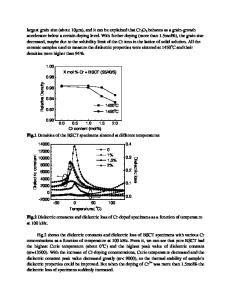Role of SrRuO 3 Buffer Layers in Enhancing Dielectric Properties of Ba 0.5 Sr 0.5 TiO 3 Tunable Capacitors
- PDF / 350,172 Bytes
- 6 Pages / 418.68 x 637.2 pts Page_size
- 86 Downloads / 402 Views
ABSTRACT BaM.sSr 0 fTiO 3 (BST) is a first candidate material for the development of voltage-tunable microwave devices, such as, filter, phase-shifter and VCO. In this work, crystal structures and dielectric properties of BST film are investigated with and without SrRuO 3 (SRO) buffer layers. BST and SRO thin films are sequentially prepared by pulsed laser deposition and Au/Ti metal electrodes are fabricated by a DC magnetron sputtering system. The capacitance of the capacitors has been measured as a function of bias voltages at room temperature using a low frequency LCR meter. For the high frequency characteristics (-2GHz), a microstrip resonator with -2GHz resonance frequency and the center coupling design is fabricated. Using flip-chip BST capacitor attached at the position of the center coupling on the microstrip resonator, Its dielectric loss and tunability were obtained. The microwave loss was obviously enhanced in the film with SRO buffer layer..
INTRODUCTION Ferroelectric (FE) thin films with large dielectric nonlinearity and very low dielectric loss are increasingly considered to be promising for voltage-tunable microwave devices, such as resonators, filters, antennas and delay lines with reduced length scales since the fabricdion technique of FE thin films have been impressively developed. [1] Electronic tunability of the operation frequency is related to nonlinear dielectric constant, which can be tuned by an applied bias voltage. Dielectric loss in the FE thin film plays a crucial role in determining the performance of electrically tunable devices.[2] The interface effect of the capacitance hysteresis on voltage-capacitance characteristics was already investigated between Ag/YBCO/BST structure and Cu/Cr/BST structure. [3] Therefore, in this study, the dielectric properties of the FE Bao.sSrof5 TiO 3 (BST) film deposited on the LaAlO 3 (LAO) substrates were investigated at the range of microwave frequency. The measurements were performed using a resonator incorporated with a flip-chip structure. For the resonator design, a conventional end-coupled approach was used. The resonator was basically designed to have different capacitance between the poles which is determined by the separation gap of each end-coupled resonator section. Microwave properties, capacitance (C) and dielectric loss ( tanb) of the BST thin film with or without SRO buffer layer were described as a function of bias voltages. It seems to help to understand interfacial effect between the FE thin film and the electrode.
187
Mat. Res. Soc. Symp. Proc. Vol. 603 ©2000 Materials Research Society
EXPERIMENT Testing chip capacitors were fabricated on LaA10 3 substrate. BST films were deposited using a pulsed laser deposition with 248nm KrF excimer laser(Lambda Physik 300)., which is widely used for the growth of high temperature superconductors and dielectric oxide films. Deposition of BST was performed in the pure oxygen pressure of 50mTorr and substrate temperature of 750 yielded the film deposition rate of 0.35 A /pulse. The thickness of
Data Loading...











